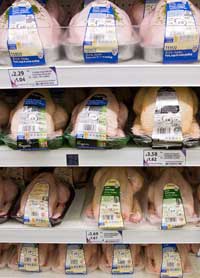Broiler sector well placed in downturn

Broiler producers are well set to buck the economic trend, with consumers becoming more focused on buying value meat.
Speaking at the South and Western Chicken Industry Association’s 21st annual conference in Devon last month, Andrew Tempest, sales and marketing director at Faccenda, said consumers’ buying habits were changing quickly.
“The past 12 months have seen the biggest change to consumer behaviour in 20 years. They are trading down into chicken from pork, lamb and beef, and making value decisions in ways they have never done before.”
People were eating more as a family and becoming more careful with their spending; buying value cuts like legs, which made carcass balancing far easier, said Dr Tempest. Instead of promotional activity they wanted every day low pricing, and were moving away from pre-packaged products to deli fresh meat to minimise waste, he added.
“Price is very important in the current market – it is the value retailers that are growing.” But with every retailer short of chicken, producers were well placed to demand a sustainable price, he said. “2009 is going to be a tough year – there is a lot of competition out there – but there’s a shortage of chicken and it’s definitely the industry that might buck the trend.”
Jon Grimes, senior certification officer at the Soil Association, admitted that there had been a shift away from organic chicken in recent months, following a period of strong growth. “But it’s very mixed between retailers, and we believe there is still a core organic consumer out there.”
The long-term outlook was still positive, and the key priorities for the Soil Association were now addressing high feed costs and considering alternative breeds, said Mr Grimes. Options included promoting home-grown proteins, as well as adding herbs and beetle banks to the range, or potentially introducing slower-growing breeds which required lower protein feeds, he said.
Broiler health in the UK is extremely good, but new regulations are coming in and producers need to be ever vigilant, according to poultry vet Stephen Lister of Crowshall Veterinary Services.
That was the key message speaking at the Speaking at the South and Western Chicken Industry Association’s 21st annual conference in Devon last month.
Severe infectious disease rates were incredibly low, but sub-clinical diseases like Coccidiosis and poor gut integrity were more problematic, he said. “There is still work to do there.” Gut flora promoters were a possible answer to boosting gut health, which would improve litter quality and growth rates, he added.
New legislation on the horizon included the EU Broiler Directive – the first specific welfare legislation for broilers, which was due to come into force in June 2010. “The good thing is that most of it is common sense and much will mirror current best practice.”
The Salmonella National Control Plan was also coming in, requiring regular testing of houses, and talks on cost sharing with DEFRA were ongoing, but could result in an annual levy of 0.04p/poultry place, said Mr Lister.
Stringent biosecurity measures to prevent a costly disease outbreak were therefore essential. “Expect the unexpected – contingency planning for all of us is vital,” said Mr Lister.
Attention to detail, benchmarking, and professional business planning are the keys to successful broiler production, according to Cargill Meats.
The firm produced 1.5m conventional, freedom food and free-range birds a week worldwide, and was continually working to improve output, said Stephen Dart, broiler production manager at Cargill Meats Europe.
Broilers had six basic needs to perform well: good air quality, good quality feed, clean water, good litter to sit on, adequate down-time between flocks, and a clean environment. Any failure to provide these to the highest standard would affect production, he said.
The best Cargill producers made 6p/kg more in margin than the worst performers, proving the importance of benchmarking and improving the business based on factual evidence, said Mr Dart. “Without question, in this industry, information is power.”
Producers had to understand the breed’s strengths and weaknesses, know the potential of their raw materials, employ the best people and the highest bio-security, and plan a flexible strategy to capitalise on their strengths, he added. “Both standard and extensive production systems will be part of our future. But maintenance of high production standards is vital to securing a place in an ever increasing global supply chain.”
